School
The Ding Dong Dog of Cuminestone

Newport News Daily Press - Dec 15, 1963
Posted By: Alex - Fri Oct 25, 2024 -
Comments (0)
Category: School, Dogs, 1960s
Science Fair Heart Transplant
March 1968: Robert McDavid, a junior at Schulte High School in Terre Haute, Indiana, performed a heart transplant on a live rabbit for his science fair project. School administrators had approved his project. In fact, they applauded it as highly topical since the first successful human heart transplantation had been performed just the year before by the South African surgeon Christiaan Barnard.After performing the operation, McDavid measured the length of time that the rabbit's body functioned with the new organ. He later exhibited the results of his project at the Regional Science Fair of Indiana State University and received an award for creativity in his field.
Questioned by reporters, McDavid revealed that he had prepared for the procedure by first conducting a number of practice operations, including skin grafts and bone section transplants on chickens. He said that he had also read a number of books about transplants and had conducted interviews with several physicians.
I haven't been able to track down if McDavid went on to become a surgeon.


Terre Haute Tribune - Mar 17, 1968
Posted By: Alex - Mon Oct 14, 2024 -
Comments (4)
Category: School, Science, Surgery
EMAG-3
I did a science fair project in high school, but I put so little effort into it that I'm now embarrassed thinking back on it. The topic I chose was "The Electrolysis of Water." I basically just had some electrodes splitting water into hydrogen and oxygen.David Ecklein, however, had an extraordinary high school science fair project. Back in 1959, he built a computer, which he named EMAG-3, that was capable of playing "an interesting and reasonable game" of checkers. It was made from 3200 vacuum tubes and three miles of wiring. It stood 15 feet tall.
On his website, he notes that he designed it to fit the science fair floor space requirements, knowing that the regulations had omitted to mention anything about how high a project could be. Height restrictions were introduced the following year.
More info: MIT Museum
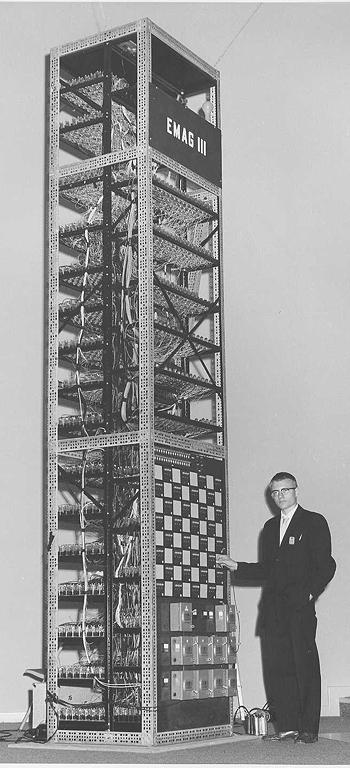
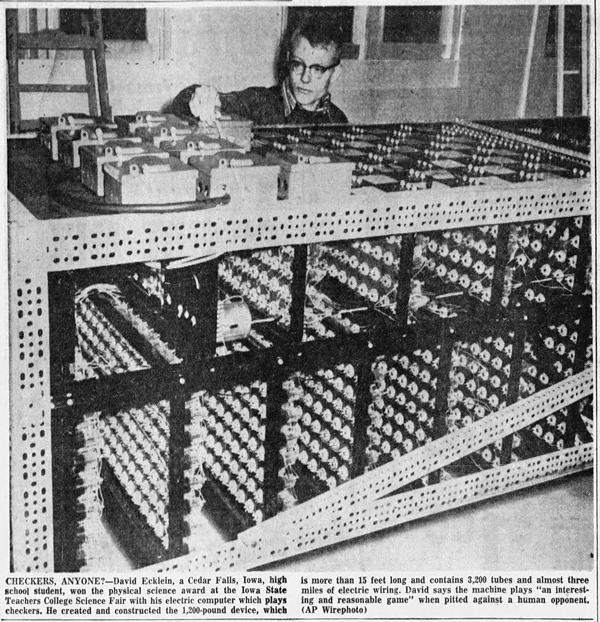
Great Falls Tribune - Apr 17, 1959
Posted By: Alex - Tue Sep 13, 2022 -
Comments (6)
Category: School, Technology, Computers, 1950s
Toe-Popper Returns
Olayinka Alege made the news (including News of the Weird) back in 2009. As Assistant Principal of Tampa's King High School, he was in the habit of disciplining students with sagging grades by "toe-popping" them. This involved having them remove their shoes and socks, then bending or pulling a toe until it made a popping noise. This didn't hurt, but the students understandably were weirded out by it. One student was toe-popped twenty times.Last month Alege was back in the news. He's now up in Providence, RI, but still working in the public school system. He's been charged with forcibly massaging a student's feet. For the record, he's pleading not guilty.
Posted By: Alex - Sat Jun 26, 2021 -
Comments (1)
Category: Crime, School, Feet
Father Christmas Training School
It's still kinda the holiday season, right? Orthodox Xmas was just a few days ago!
Posted By: Paul - Mon Jan 11, 2021 -
Comments (0)
Category: Holidays, School, United Kingdom
Students stunned as teacher bites head off chicken
The incident that occurred in the 'leadership training' class of Sgt. Maj. Jimmy Powell on Sep 1, 1983, as described by his superior, Col. Donald Taylor:He held out the neck of the chicken, bit the head off the thing, held it up in the air, and drank the blood of the chicken.
And then on speaking to Powell later about the incident:
The course Powell was teaching was not a survival class but is largely concerned with administrative matters, such as 'how the uniform is worn,' Taylor said.
Compare this to the pre-game frog-head biting that was practiced at Eau Gallie High School in Florida.
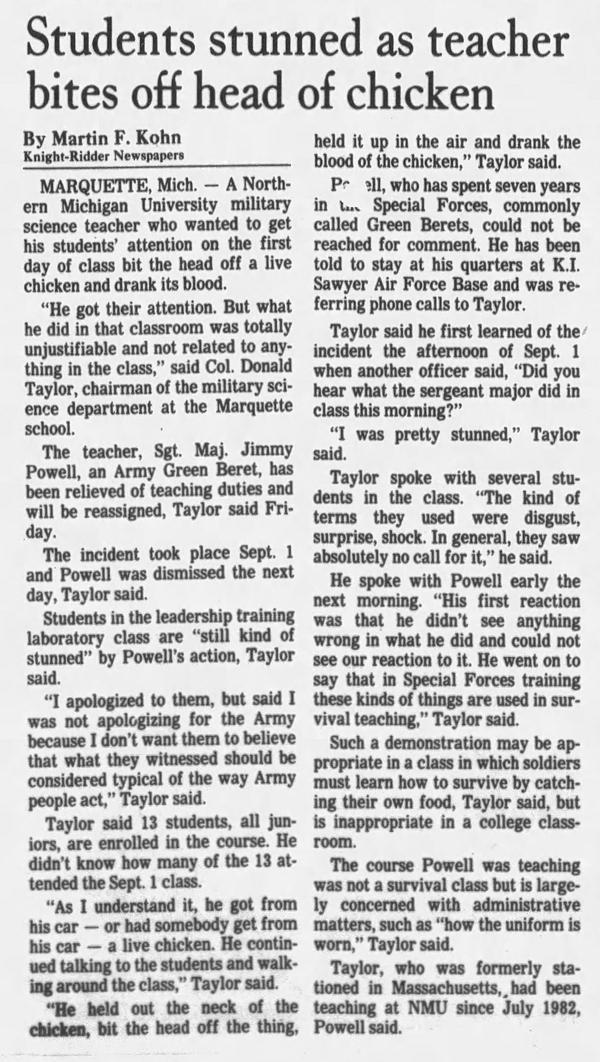
Mansfield News-Journal - Sep 17, 1983
Posted By: Alex - Thu Dec 31, 2020 -
Comments (2)
Category: Animals, School
Graduated Alone
May 1949: Eva Mae Bradbury was the only member of her graduating class at the public school in Ada, Kansas. The school nevertheless put on a full commencement program for her, attended by 150 people (which was about the entire population of Ada).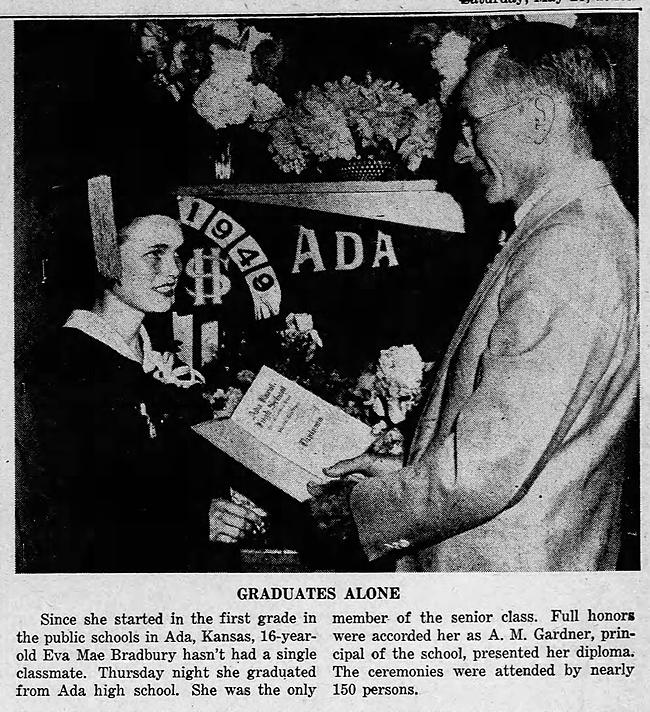
Decatur Herald and Review - May 21, 1949
Posted By: Alex - Thu Nov 05, 2020 -
Comments (2)
Category: School, 1940s
How to raise a genius
According to Harold G. McCurdy, a professor at the University of North Carolina, the first step was to not send your kids to public school.Not that he had anything against public schools, having sent his own kids to one. And he questioned whether raising kids to be geniuses was a desireable goal, since he believed that geniuses often led isolated, unhappy lives.
Nevertheless, based on his study of the childhoods of 29 geniuses, conducted back in 1960, he determined that "three striking factors seemed to be typical of the childhood pattern of genius":
"Public school education," he declared, "works against these three things."
Apparently McCurdy's study has been embraced by some proponents of home schooling. Although I don't get the sense that it was his intention to promote that.
You can read McCurdy's full study here: The Childhood Pattern of Genius
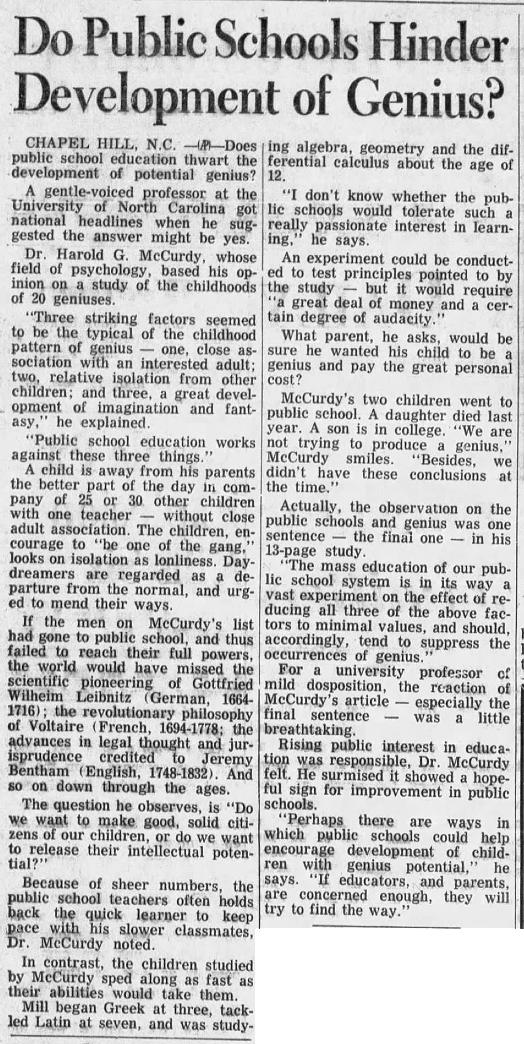
The Oklahoma Daily - Feb 17, 1961
Posted By: Alex - Thu Oct 15, 2020 -
Comments (5)
Category: Education, Intelligence, School, 1960s
Temporarily Blind
May 1974: Three students at Northeast High School in Philadelphia participated in a medical experiment in which for five days they experienced what it was like to be blind.I'm guessing this kind of experiment would never be allowed nowadays in a high school.
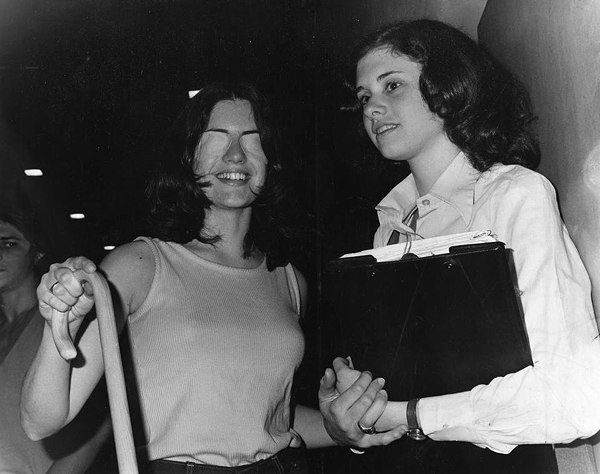
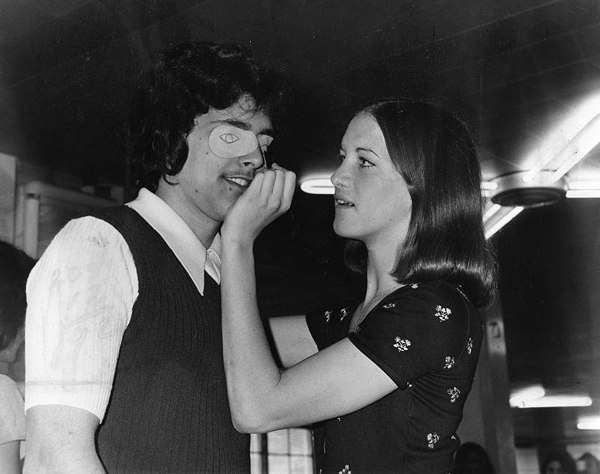
Source: Temple University digital collections (image one, image two)
Posted By: Alex - Mon Oct 09, 2017 -
Comments (2)
Category: School, Experiments, 1970s
Paid to teach empty classroom
An early example of the "teacher paid to do nothing" phenomenon. Nowadays we've got the Rubber Room.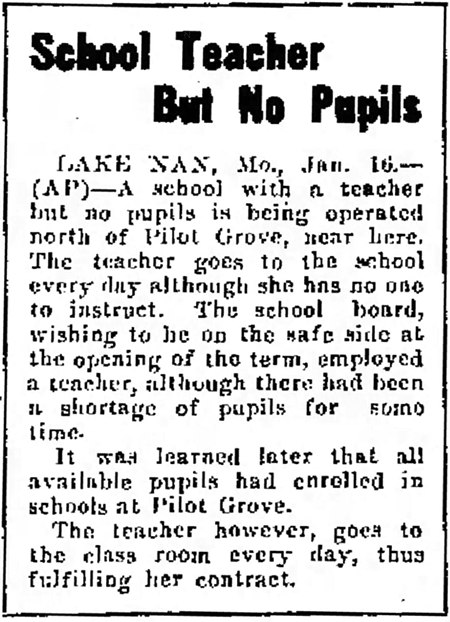
Portsmouth Daily Times - Jan 16, 1926
Posted By: Alex - Sun Aug 13, 2017 -
Comments (0)
Category: School, 1920s

| Who We Are |
|---|
| Alex Boese Alex is the creator and curator of the Museum of Hoaxes. He's also the author of various weird, non-fiction, science-themed books such as Elephants on Acid and Psychedelic Apes. Paul Di Filippo Paul has been paid to put weird ideas into fictional form for over thirty years, in his career as a noted science fiction writer. He has recently begun blogging on many curious topics with three fellow writers at The Inferior 4+1. Contact Us |




